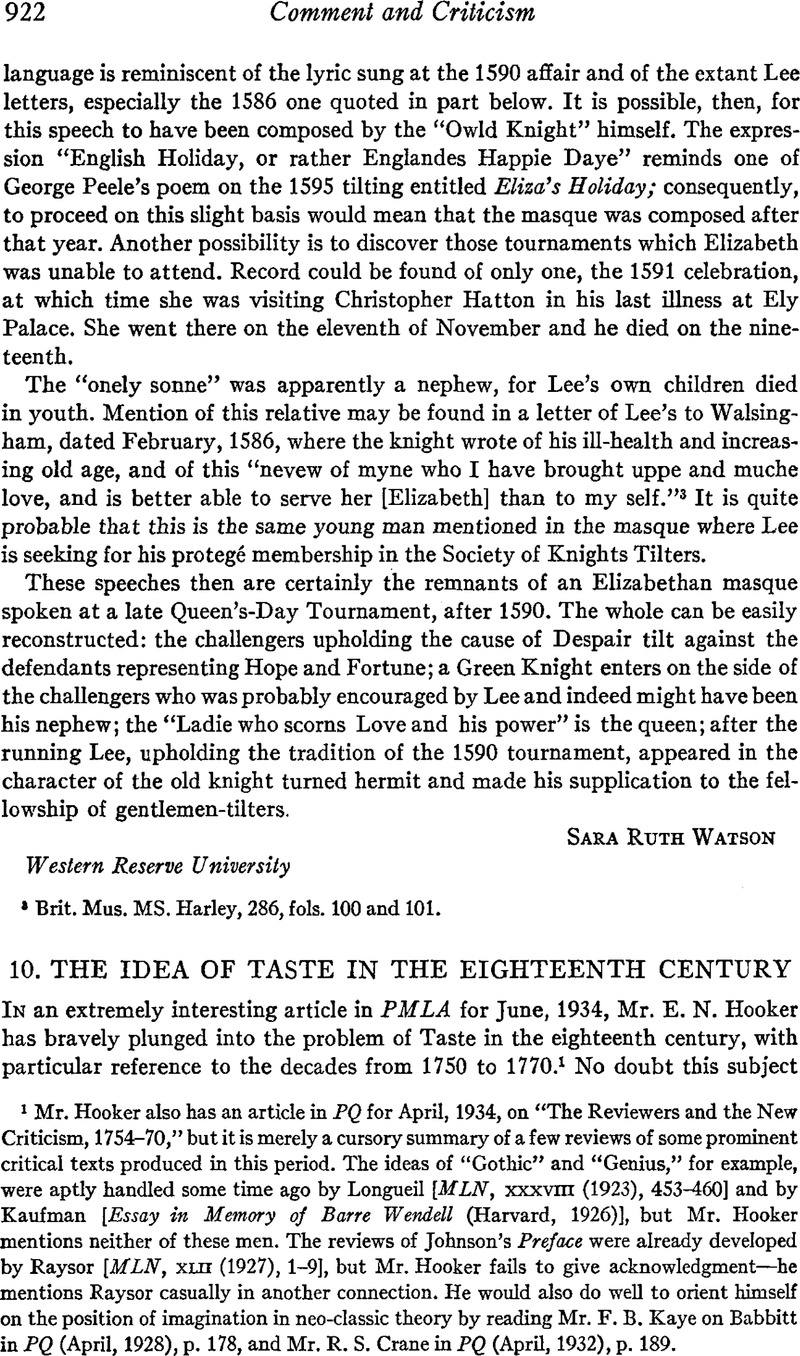Article contents
The Idea of Taste in The Eighteenth Century
Published online by Cambridge University Press: 02 December 2020
Abstract

Information
- Type
- Comment and Criticism
- Information
- Copyright
- Copyright © Modern Language Association of America, 1935
References
1 Mr. Hooker also has an article in PQ for April, 1934, on “The Reviewers and the New Criticism, 1754–70,” but it is merely a cursory summary of a few reviews of some prominent critical texts produced in this period. The ideas of “Gothic” and “Genius,” for example, were aptly handled some time ago by Longueil [MLN, xxxviii (1923), 453–460] and by Kaufman [Essay in Memory of Barre Wendell (Harvard, 1926)], but Mr. Hooker mentions neither of these men. The reviews of Johnson's Preface were already developed by Raysor [MLN, xlii (1927), 1–9], but Mr. Hooker fails to give acknowledgment—he mentions Raysor casually in another connection. He would also do well to orient himself on the position of imagination in neo-classic theory by reading Mr. F. B. Kaye on Babbitt in PQ (April, 1928), p. 178, and Mr. R. S. Crane in PQ (April, 1932), p. 189.
2 Englische Studien, lxvi (1931), 279–81.
3 MP, xxix (1931), 251–252.
4 MLN, xxvii (1932), 118–120.
5 MP, xxx (Feb., 1933), 309–316.
6 The date of Burke's essay on Taste Mr. Hooker confuses twice as of 1770 and 1756 (p. 581 n). It was really prefixed to the edition of 1759.
7 Why, also, should Mr. Hooker ignore such a point of view as Mr. Havens' in “Changing Taste in the Eighteenth Century,” PMLA, xliv (June, 1929), 501–536? There is, further, such semi-popular material as E. E. Kellett's The Whirligig of Taste (Hogarth, 1929) and Fashion in Literature: A Study in Changing Taste (Routledge, 1931). And what of Mr. F. P. Chambers' The History of Taste (Columbia Univ., 1932)?
8 P. 590.
9 P. 577.
10 P. 579.
11 P. 579.
12 P. 586.
13 P. 586.
14 P. 580.
15 P. 580.
16 P. 587.
17 P. 591.
18 P. 589.
19 P. 585.
20 P. 591.
21 One might even add to it pieces on Beauty, such as the following: New Memoirs of Literature, i (1725), 51; British Magazine, ii (1747), 49; Rambler (1750–52), No. 92; Adventurer (1753–54), No. 82; Critical Rev., iii (1757), 366; European Magazine, vi (1784), 187; Universal Mag., lxxix (1786), 4 and lxxxiv (1789), 322, 364; Hibernian Mag., 1790, Pt. 2, p. 104 and 1799, Pt. 1, p. 255; Lady's Magazine, xxii (1791), 205; Monthly Rev., xxv (1798), 584 (rev. of Kant on the Beautiful)—not in index; Universal Mag., ciii (1798), 197 and cv (1799), 10; Monthly Mirror, vii (1799), 148. And see indexes to the Gentleman's Mag. (1731–87 and 1787–1818) and the Monthly Rev. (vol. ii). There is also a second series of the Monthly, beginning in 1790.
- 3
- Cited by

